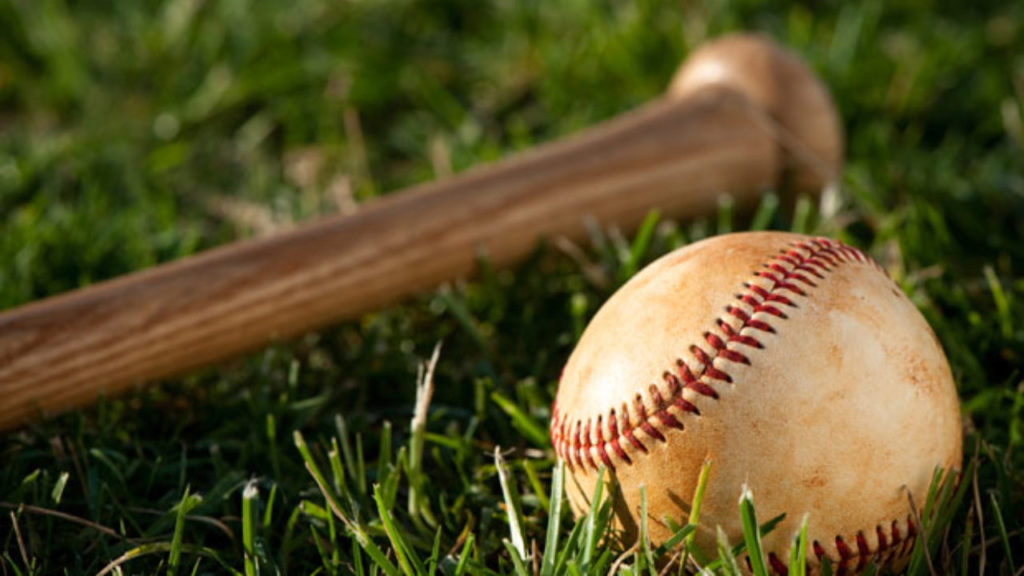There’s a lot out there about baseball. There are baseball books, baseball poems, baseball songs, baseball movies, baseball science experiments, baseball math challenges, baseball arts and crafts, and baseball philosophy. Yes, really. Baseball philosophy.
Check it all out:
Table of Contents
BASEBALL STORIES
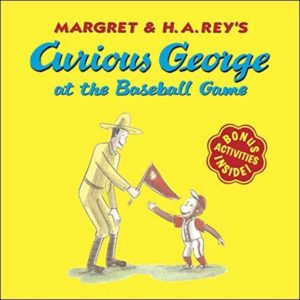
|
In Curious George at the Baseball Game by H.A. Rey and Margret Rey (Houghton Mifflin, 2006), George and the Man in the Yellow Hat go to watch the Mudville Miners play ball and the well-meaning but inquisitive little monkey – as always – manages to get in trouble. For ages 3-7. |
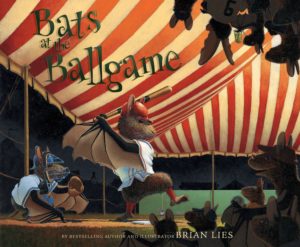
\
|
To Bats at the Beach and Bats at the Library, Brian Lies now adds the equally adorable Bats at the Ballgame (Houghton Mifflin, 2010), a delightfully illustrated account of bat-style baseball, complete with mothdogs, Cricket Jack, and fans hanging upside-down in the stands. For ages 4-8. |
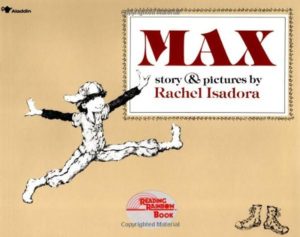
|
The baseball-playing title character of Rachel Isadora’s Max (Aladdin, 1984), en route to baseball practice, walks his sister Lisa to her ballet lesson, is invited to join the class, and discovers that he loves to dance. Soon he finds that he can happily participate in both worlds – baseball and ballet. A nice anti-stereotype picture book for ages 4-8. |
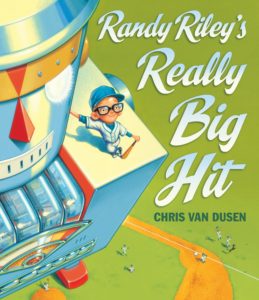
|
Randy Riley, the title character of Chris Van Dusen’s Randy Riley’s Really Big Hit (Candlewick, 2012), isn’t much good at baseball, but he’s a whizz at science and math. When he spots an Earth-heading meteor through his telescope, he saves the day by cleverly calculating trajectories and building an enormous robot who smacks the fireball back into space with a smokestack baseball bat. For additional oomph, the story is told in the rhyme and rhythm of “Casey at the Bat” (see below). For ages 5-9. |
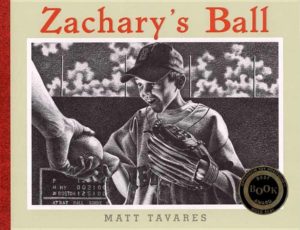
|
Matt Tavares has written and illustrated several superb baseball picture books, among them Zachary’s Ball (Candlewick, 2012), in which Zachary’s father catches a foul ball at Fenway Park, which magically causes Zachary’s baseball fantasies to come true. The story is enchanting and the illustrations are marvelous. Other titles include Mudball, Oliver’s Game, There Goes Ted Williams, Growing Up Pedro, Becoming Babe Ruth, and Henry Aaron’s Dream. For ages 6-9. |
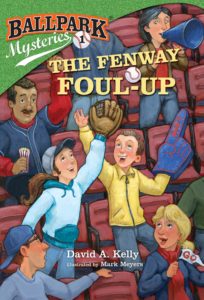
|
In David A. Kelly’s Ballpark Mysteries series – beginning with The Fenway Foul-Up (Random House Books for Young Readers, 2011), Mike and Kate – nine-year-old cousins with a knack for detective work – solve baseball-related mysteries. Each book manages to work in a bit of baseball history along with the action. For ages 6-9. |
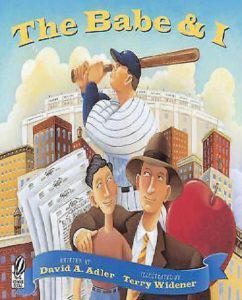
|
In David A. Adler’s The Babe and I (Sandpiper, 2004), set in 1932 in the Bronx at the height of the Great Depression, the young narrator and his best friend Jacob struggle to earn money by selling newspapers near Yankee Stadium, and shouting out the latest about the famous Babe Ruth. The business takes off, with a boost from the Babe himself – but the real message of the book is that working together as a team is the best way to get through hard times. For ages 5-9. |
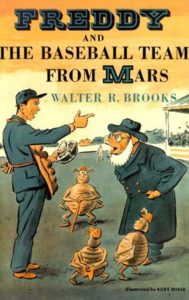 |
Freddy and the Baseball Team from Mars (Overlook Juvenile, 2011) is one of Walter R. Brooks’s hilarious Freddy the Pig series, starring the ever-inventive Freddy and all his animal friends on the Bean farm. For ages 5 and up. |
| Become a Friend of Freddy and learn more about his books and escapades at Freddy the Pig’s Home Page. |
|
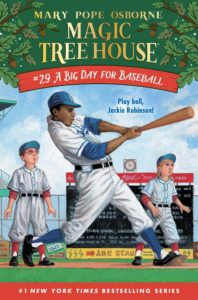
|
In Mary Pope Osborne’s A Big Day for Baseball (Random House, 2017), one of the Magic Tree House series, Jack and Annie travel back in time to Brooklyn, New York, in 1947, where they end up as batboys in a game with Jackie Robinson. For ages 6-9.
Also see Baseball, a Magic Tree House Fact Tracker and nonfiction companion to the book. |
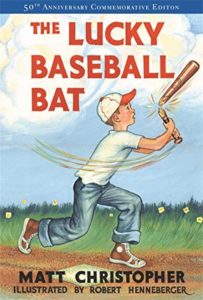
|
In Matt Christopher’s The Lucky Baseball Bat (Little, Brown, 2004), originally published in 1954, Martin, new in town, is anxious to do well on the baseball field – and he does, until his lucky baseball bat breaks. Predictably, he eventually discovers that ability really comes from within himself. Christopher is the author of over 100 books with sports themes, many about baseball, for ages 7-10. |
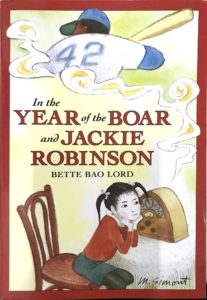
|
In Bette Bao Lord’s In the Year of the Boar and Jackie Robinson (HarperCollins, 1986), ten-year-old Bandit leaves China with her mother to join her father in New York City. Excited, she adopts the new American name of Shirley Temple Wong – but America isn’t quite what she had expected, and Shirley struggles with a new language, new customs, and the difficulty of fitting in. Then she discovers baseball – and what’s more, the year is 1947 and Jackie Robinson has just become the first black player to join a white major-league team. Inspired by his example, Shirley discovers that for her, too, America can truly be a land of opportunity. For ages 8-12. |
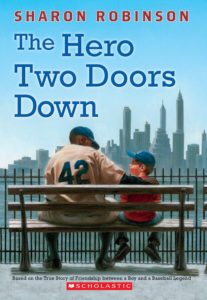 |
Sharon Robinson’s The Hero Two Doors Down (Scholastic, 2016), set in 1948, is based on a true story about the friendship between a young white boy in Brooklyn and baseball hero Jackie Robinson. For ages 8-12. |
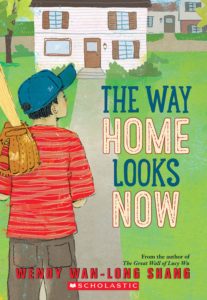 |
By Wendy Wan-Long Shang, The Way Home Looks Now (Scholastic, 2015) is the story of a Chinese-American family whose love for baseball ultimately help them heal after Peter’s older brother is killed in a car accident. For ages 8-12. |
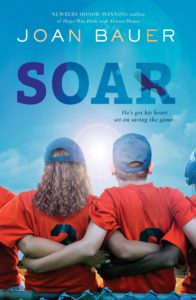
|
In Joan Bauer’s Soar (Viking, 2016), Jeremiah, who has a heart condition, and his father have moved to a town where the death of a school baseball player and a scandal have crushed the entire community. When Jeremiah decides to become a baseball coach, however, his wit and courage help the town heal. A coming-of-age story for ages 9-12. |
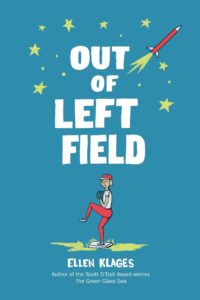 |
In Ellen Klages’s Out of Left Field (Viking, 2018), set in 1967, every boy in the neighborhood knows Katy is the best pitcher going – but she’s a girl and is not allowed to join the Little League. Determined Katy protests and sets out to learn the forgotten history of female baseball players. For ages 9-12. |
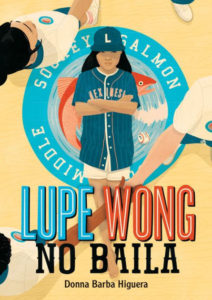 |
Lupe, of Donna Barba Higuera’s Lupe Wong Won’t Dance (Levine Querido, 2020) is a middle-grade star athlete who dreams of meeting her hero, Fu Li Hernandez, a pro baseball player of mixed Chinese and Mexican heritage, just like hers. All she needs is a straight-A school record, which looks like a shoe-in – until the final gym unit turns out to be square dancing. Lupe, horrified, does everything she can to eliminate square dancing, from researching the racist history of the music to protesting enforced gender roles. Nothing seems to work. For ages 9-12. |
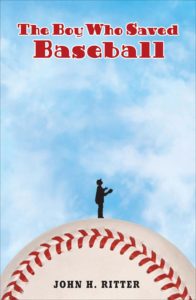
|
In John H. Ritter’s The Boy Who Saved Baseball (Puffin, 2005), there’s a lot riding on a baseball game. Set in rural California, Doc Altenheimer, an elderly apple rancher, is preparing to sell his land – which makes up most of the little town of Dillontown – to developers. Unless, that is, the scruffy town baseball team can manage to defeat the team of the well-equipped suburbanites who live down the road. Twelve-year-old Tom helps recruit the reclusive Dante Del Gato, an old baseball legend, to coach the home team, and the contest is on. For ages 10-13. |
| Ritter has written several other baseball-themed books for the same age group, among them Over the Wall, Choosing Up Sides, Under the Baseball Moon, and The Desperado Who Stole Baseball. | |
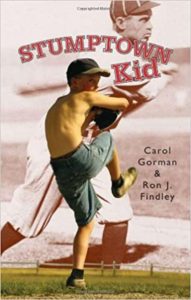
|
In Stumptown Kid by Carol Gorman and Ron Findlay (Peachtree Publishers, 2007), it’s 1952 and 11-year-old Charlie is mourning his father, killed in the Korean War, resenting his mother’s thuggish boyfriend, and loving baseball – though he’s not good enough to play on the Wildcats, the prime local team. Then he meets Luther Peale, an ex-Negro League pitcher, on the run after pitching a ball that killed a drunken white batter. With the help of Luther, Charlie and friends forge a team capable of beating the Wildcats – though meanwhile around town, racial tensions rise, and the vengeful brother of the dead batter is on Luther’s trail. For ages 10-13. |
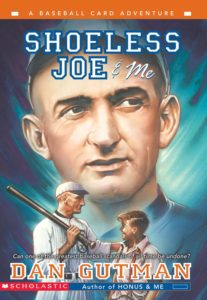 |
Joe Shostack, the 12-year-old hero of Dan Gutman’s Baseball Card Adventure series, is able to travel through time with the help of vintage baseball cards. In the first book of the series, Honus and Me (HarperCollins, 1998), Joe finds a rare Honus Wagner baseball card (see Baseball Biographies, below) while cleaning out a neighbor’s attic which enables him to travel back to the 1909 World Series. In other volumes, Joe meets such baseball greats as Babe Ruth, Jackie Robinson, Mickey Mantle, Roberto Clemente, Shoeless Joe Jackson, and – this time by means of a photograph – Civil War General Abner Doubleday, who may or may not have invented the game of baseball. A nice combination of real history, adventure, human relationships, and – of course – baseball. For ages 10 and up. |
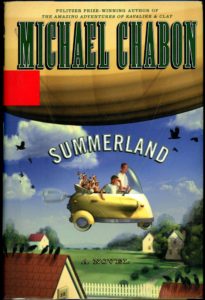
|
Michael Chabon’s Summerland (Hyperion Books, 2011) is fantasy baseball, and I mean fantasy baseball. Eleven-year-old Ethan – a lousy ballplayer – and his father have moved to an island off the coast of Washington, whose westernmost tip, called the Summerland, is known for its perfect sunny weather. The Summerland is also a portal to other worlds, and there a mysterious and ancient baseball scout recruits Ethan and friends to save both our world and the world of the fairy-like ferishers from the evil trickster Coyote and his warriors. Giants, legendary liars, a depressed Sasquatch, a werefox – and some truly high-stakes baseball. For ages 11 and up. |
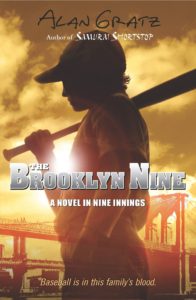
|
Alan Gratz’s The Brooklyn Nine (Puffin, 2010) traces the generations of a Brooklyn family and its ties to baseball through nine sequential historical “innings.” The book begins with ten-year-old Felix Schneider who arrives in America from Germany and encounters Alexander Cartwright, possibly the founder of modern baseball, during the Manhattan fire of 1845. Subsequent chapters deal with the Civil War, the years of the Negro Leagues and struggles with racial prejudice, the All-American Girls League, and the Cold War era. Wonderful characters (both male and female), discussion-worthy themes, and compelling stories. For ages 10 and up. |
| Also see The Brooklyn Nine Webquest. The premise: you have just found an old cardboard box in a back room of your uncle’s antique shop that turns out to be full of baseball memorabilia. Your mission: find the story behind this stuff. (Along the way kids learn to make idea maps and to design their own baseball cards.) | |
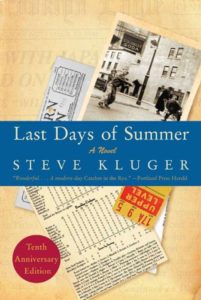
|
Steve Kluger’s Last Days of Summer (William Morrow, 2008) is funny, sad, uplifting, and a gem. The protagonist is twelve-year-old Joey Margolis, a brilliant loudmouth Jewish kid from Brooklyn in the 1940s. Joey, who lives with his divorced mother, is a victim of neighborhood bullies – in part because he has (a lie) boasted that he is a friend of Charlie Banks, a player for the New York Giants. Eventually, by dint of sheer persistence, he does become friends with Charlie, and it’s a wonderful, funny, and ultimately bittersweet relationship, when Charlie goes to war. The book is told entirely in letters, interviews, memos, newspaper clippings, and Top Secret messages between Joey and his best friend Craig Nakamura (a.k.a. The Green Hornet) who lives in the apartment downstairs. Highly recommended for teenagers and adults. |
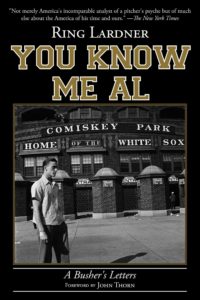
|
American journalist and short-story writer Ring Lardner’s You Know Me Al (Touchstone, 1991), originally published in 1914, is a baseball classic, written in the form of letters from Jack Keefe, a pitcher with the Chicago White Sox, to Al, his buddy back home in Indiana. Jack is vain, clueless, poignant, and inadvertently hilarious. For high-school-level students and up. |
| You Know Me Al is a free audio version from Books Should Be Free. | |
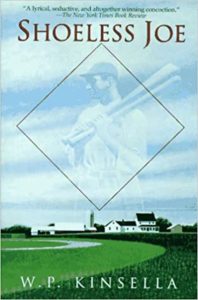
|
The book behind the popular movie Field of Dreams, W.P. Kinsella’s Shoeless Joe (Mariner Books, 1999) uses baseball as a means of fulfilling dreams, healing wounds, and celebrating love, family, and the miracles of the everyday. Spurred by a mysterious voice saying “If you build it, he will come,” Ray Kinsella builds a baseball diamond in the middle of his Iowa cornfield. Wonderful and evocative. For teenagers and adults. |
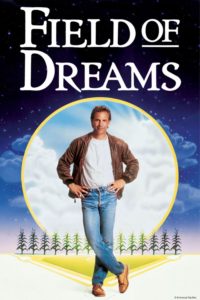 |
The 1989 movie Field of Dreams, stars Kevin Costner, Amy Madigan, James Earl Jones, and Burt Lancaster. Rated PG. |
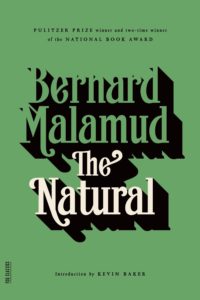 |
Bernard Malamud’s The Natural (Farrar, Straus & Giroux, 2003), originally published in 1952, overlays baseball with Arthurian legend in the tale of a tragic hero, the supremely talented, but ultimately flawed, Roy Hobbs. Deservedly on many high-school reading lists. |
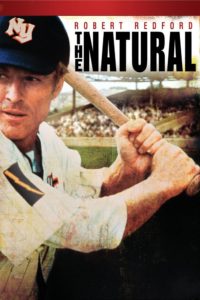 |
The 1984 movie The Natural, starring Robert Redford as Roy Hobbs, takes liberties with Malamud’s plot and is a far sunnier and more sentimental story than the author intended. Rated PG; available on DVD and Blu-Ray. |
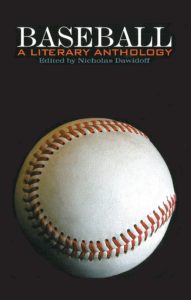
|
Baseball: A Literary Anthology (Library of America, 2002), edited by Nicholas Dawidoff, is a wonderful (and enormous, over 700 pages long) collection of short stories, essays, profile pieces, and poems – all on baseball or baseball players – by such writers as Ring Lardner, Roger Angell, John Updike, Damon Runyon, James Thurber, William Carlos Williams, and Marianne Moore. First selection in the book – naturally – is Ernest Thayer’s classic poem “Casey at the Bat.” For teenagers and adults. |
